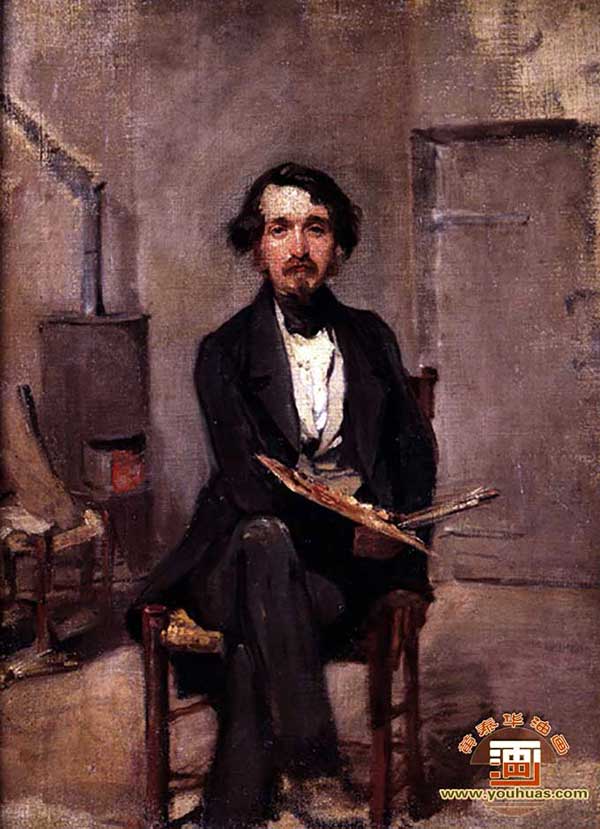[阿尔弗雷德·埃米尔·利奥波德·史蒂文斯]

阿尔弗雷德·埃米尔·利奥波德·史蒂文斯(1823年5月11日- 1906年8月24日),比利时画家。
史蒂文斯是19世纪后期比利时杰出的现实主义画家。史蒂文斯主要活跃于巴黎,起初受科罗优雅画风影响,他1855年的作品《流浪》展出后使政坛为之震动。34岁以后他全力描绘在高雅的房间里鉴赏绘画或东方艺术品的优雅少女。他的作品完全遵循传统。不过他响应波德莱尔面向现实题材的号召,盛赞马奈、布丹的作品,这还影响了惠斯勒和萨金特等。57岁以后他在海边静养,专门描绘海景。这幅《捉迷藏》,实际上画家是借捉迷藏游戏描绘美丽少女形象和室内装饰,高贵典雅的人物和环境和谐统一,画家从日常的风俗题材中表达了对生活的热爱。
阿尔弗雷德·史蒂文斯出生于布鲁塞尔。他来自一个从事视觉艺术的家庭:他的哥哥约瑟夫(1816-1892)和儿子利奥波德(1886 -1935)是画家,而另一个哥哥亚瑟(1825-99)是一位艺术品交易商和评论家。他的父亲曾在荷兰威廉一世(William I)的军队里参加过拿破仑战争,是一位艺术收藏家,拥有尤金德拉克罗瓦(Eugene Delacroix)和其他艺术家的几幅水彩画。他母亲的父母在布鲁塞尔开了一家名为“友谊咖啡馆”(Cafe de l’amitie)的咖啡馆,是政治家、作家和艺术家的聚会场所。所有斯蒂文斯的孩子都从他们在那里遇到的人,以及他们在成长过程中在重要人物身边学到的社交技巧中受益。
1837年,父亲去世后,史蒂文斯离开中学,前往布鲁塞尔皇家美术学院(academy ie Royale des Beaux-Arts)学习。在那里,他认识了新古典主义画家弗朗索瓦·纳维兹(Francois Navez)。按照传统的课程,他在头两年从古典雕塑的模型中提取素材,然后从真人模型中提取素材。1843年,斯蒂文斯去了巴黎,加入他已经在那里的哥哥约瑟夫的行列。他被巴黎最重要的艺术学院巴黎美术学院录取。尽管有人说他是导演让·奥古斯特·多米尼克·安格尔的学生,但这可能不是真的。史蒂文斯早期的一幅画《赦免或赦免》(The Pardon or Absolution, Hermitage, St. Petersburg)于1849年签署,日期为1849年。这幅画显示了他对传统自然主义风格的掌握,这在很大程度上要归功于17世纪的荷兰风俗画。就像比利时画家、他在巴黎的朋友弗洛伦斯·约瑟夫·玛丽·威勒姆斯(Florent Joseph Marie Willems, 1823-1905)一样,史蒂文斯仔细研究了杰拉德·特尔·伯奇(Gerard ter Borch)和加布里埃尔·梅苏(Gabriel Metsu)等画家的作品。
Alfred émile Léopold Stevens (11 May 1823 - 24 August 1906) was a Belgian painter.
Alfred Stevens was born in Brussels. He came from a family involved with the visual arts: his older brother Joseph (1816-1892) and his son Léopold (1866-1935) were painters, while another brother Arthur (1825-99) was an art dealer and critic. His father, who had fought in the Napoleonic wars in the army of William I of the Netherlands, was an art collector who owned several watercolors by Eugène Delacroix, among other artists. His mother's parents ran Café de l'Amitié in Brussels, a meeting place for politicians, writers, and artists. All the Stevens children benefited from the people they met there, and the social skills they acquired in growing up around important people.
After the death of his father in 1837, Stevens left middle school to begin study at the Académie Royale des Beaux-Arts in Brussels, where he knew François Navez, the Neo-Classical painter and former student of Jacques-Louis David who was its director and an old friend of Stevens' grandfather. Following a traditional curriculum, he drew from casts of classical sculpture for the first two years, and then drew from live models. In 1843, Stevens went to Paris, joining his brother Joseph who already was there. He was admitted to the école des Beaux-Arts, the most important art school in Paris. Although it is said that he became a student of its director Jean Auguste Dominique Ingres, this is likely not true. An early picture by Stevens, The Pardon or Absolution (Hermitage, St. Petersburg), signed and dated 1849, shows his mastery of a conventional naturalistic style which owes much to 17th-century Dutch genre painting. Like the Belgian painter and friend with whom he stayed in Paris, Florent Joseph Marie Willems (1823-1905), Stevens carefully studied works by painters such as Gerard ter Borch and Gabriel Metsu.
